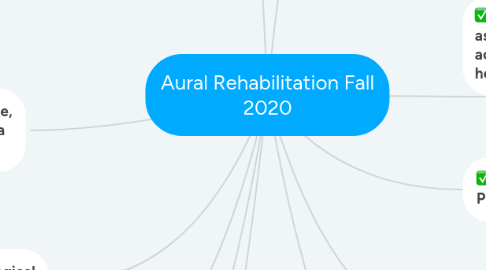
1. Hearing loss is an neurobiological emergency
1.1. The reason why hearing loss in babies has been considered a “neurobiological emergency” is because of the short window of time when there is an optimal baby's brain development for auditory neural connections to form
2. Factors that affect language, speech, and literacy in cochlea implant users
2.1. With a hearing loss there might be some difficulties in these areas. There are also at least three reasons for literacy deficit to arise in the face of significant hearing loss. First, reading and writing problems may result from a restricted language system. Second, some children do not develop auditory basis for mapping sound to print, and third, children may have deficits in experience and world knowledge.
3. Creating an inclusive classroom environment is key for the success of students with hearing loss
3.1. By incorporating ASL into the classroom, students with a hearing loss would improve their participation and engagement in class. Therefore, this would improve their academic achievement and social competence. In addition, it will enhance communication and developmental skills, helping with their rehabilitation process. Moreover, students that do not have a hearing loss will have a wider acceptance and understanding of disability. Awareness, respect, and tolerance towards diversity will increase.
4. Facilitative Language Techniques for parents
4.1. parallel task is a facilitative language technique wherein the adult provides a commentary to match the kid's play, describing what the child is doing and might be thinking and feeling. This technique does not require the child to answer directly.
5. Components of Hearing Aid Orientation:
5.1. 1. audiologist describes the function of each part of the hearing aid and ensures the patient can adjust any control
5.1.1. 2. the patient practices inserting and removing the hearing aid, and batteries with the help of a mirror sometimes
5.1.2. 3. audiologist reviews basic hearing aid maintenance and ways to clean the device, protect it, and store it at night, and also discusses how to order new batteries
5.1.3. 4. the patient practices using the telephone, using the telecoil switch if the hearing aid has one.
5.1.4. 5. audiologist reviews realistic expectations, limitations, and explains the selection of the specific hearing aid,
5.1.5. 6. patient and audiologist determine appropriate use pattern for the first weeks
5.1.6. 7. patient learns how to troubleshoot the device
5.1.7. 8. patient receives printed information about the hearing aid and warranty
5.1.8. 9. patient and audiologist agree on a follow-up time table and talk about how to monitor performance with hearing aid.

